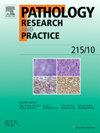癌症患者体内 miR-140-5p 表达的临床预后意义:一项元和生物信息学分析
摘要
有人研究了癌症患者体内microRNA-140-5p(miR-140-5p)表达的预后价值,但结果并不一致。本荟萃分析旨在确定 miR-140-5p 表达在各种恶性肿瘤患者中的预后意义。我们使用 PubMed、Web of Science、ProQuest、Cochrane 和 Google Scholar 进行了全面的文献检索,以确定 2023 年 6 月之前发表的相关研究。为了评估 miR-140-5p 在癌症患者总生存期(OS)和无病生存期(DFS)中的预后重要性和临床病理特征,我们计算了汇总的危险比(HR)和几率比(OR)以及 95% 的置信区间(CI)。研究人员利用 CancerMIRNome 数据库和其他 OS 分析网络服务器来探讨 miR-140-5p 的预后价值和表达谱。最终分析共纳入了 17 项研究。结果表明,miR-140-5p表达减少与较差的OS(汇总HR 0.63;95 % CI,0.51-0.79;p < 0.001)和DFS(汇总HR 0.40;95 % CI,0.25-0.64;p < 0.001)显著相关。汇总 ORs 表明,miR-140-5p 表达减少与淋巴结转移阳性(LNM;OR = 3.42;95 % CI,2.36-4.94;p < 0.001)、肿瘤晚期(OR = 2.80;95 % CI,2.07-3.78;p < 0.001)和远处转移阳性(DM;OR = 10.81;95 % CI,3.31-35.30;p < 0.001)之间存在显著相关性。在miR-140-5p表达与性别(OR = 0.94; 95 % CI, 0.70-1.28; p = 0.70)、年龄(OR = 1.31; 95 % CI, 0.99-1.74; p = 0.06)、肿瘤大小(OR = 1.55; 95 % CI, 0.77-3.10; p = 0.22)和组织学分级(OR = 1.20; 95 % CI, 0.46-3.10; p = 0.71)之间没有观察到明显的关联。亚组分析显示,在基于样本量(100)、肿瘤来源(消化道或非消化道)和癌症类型(GC/CRC)的亚组中,miR-140-5p表达减少与较短的OS相关。生物信息学分析支持了这一发现,即在大多数肿瘤组织中,miR-140-5p 被下调,其表达的降低与多种恶性肿瘤患者的不良预后有关。miR-140-5p在预测OS和DFS下降方面的预后意义表明,在治疗前测量miR-140-5p的表达水平可作为一种有价值的生物标记物,用于识别预后不良的癌症患者并改善临床治疗。The prognostic value of microRNA-140–5p (miR-140–5p) expression in cancer patients has been investigated, but with inconsistent results. This meta-analysis aims to determine the prognostic significance of miR-140–5p expression in patients with various malignancies. A comprehensive literature search was conducted using PubMed, Web of Science, ProQuest, Cochrane, and Google Scholar to identify relevant studies published before June 2023. Pooled hazard ratios (HR) and odds ratios (OR) with 95 % confidence intervals (CI) were calculated to assess the prognostic importance and clinicopathological features of miR-140–5p in overall survival (OS) and disease-free survival (DFS) of cancer patients, respectively. The CancerMIRNome database and other OS analysis webservers were utilized to explore the prognostic value and expression profile of miR-140–5p. A total of 17 studies were included in the final analysis. The results demonstrated that decreased miR-140–5p expression was significantly associated with inferior OS (pooled HR 0.63; 95 % CI, 0.51–0.79; p < 0.001) and DFS (pooled HR 0.40; 95 % CI, 0.25–0.64; p < 0.001). Pooled ORs indicated a significant correlation between reduced miR-140–5p expression and positive lymph node metastasis (LNM; OR = 3.42; 95 % CI, 2.36–4.94; p < 0.001), advanced tumor stage (OR = 2.80; 95 % CI, 2.07–3.78; p < 0.001), and positive distant metastasis (DM; OR = 10.81; 95 % CI, 3.31–35.30; p < 0.001). No significant associations were observed between miR-140–5p expression and gender (OR = 0.94; 95 % CI, 0.70–1.28; p = 0.70), age (OR = 1.31; 95 % CI, 0.99–1.74; p = 0.06), tumor size (OR = 1.55; 95 % CI, 0.77–3.10; p = 0.22), and histological grade (OR = 1.20; 95 % CI, 0.46–3.10; p = 0.71). Subgroup analyses revealed that decreased miR-140–5p expression was associated with shorter OS in subgroups based on sample size (<100 or >100), tumor origin (GI or non-GI), and cancer type (GC/CRC). Bioinformatic analysis supported the finding that miR-140–5p was downregulated in most tumor tissues, and its reduced expression was linked to poor prognosis in patients with multiple malignancies. The prognostic significance of miR-140–5p in predicting reduced OS and DFS suggests that measuring miR-140–5p expression levels before treatment could serve as a valuable biomarker for identifying cancer patients with an unfavorable prognosis and improving clinical management.

 求助内容:
求助内容: 应助结果提醒方式:
应助结果提醒方式:


